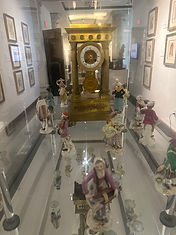What is Meissen Porcelain?
Meissen porcelain, developed in the early 18th century in Saxony, Germany, represents the first successful European attempt to replicate the fine, hard-paste porcelain of China. Founded in 1710 under the patronage of Augustus the Strong of Saxony, the Meissen manufacturing facility quickly became a symbol of artistic and technological innovation in Europe, blending East Asian influences with Baroque and Rococo aesthetics. Renowned for its exquisite and refined craftsmanship, Meissen produced both functional wares and intricate figurines that depicted mythological, biblical, and everyday scenes. The porcelain figures not only served as luxurious decorative objects but also conveyed cultural ideals, social narratives, and in some cases, moral instruction, making them valuable artifacts for understanding 18th-century European life and values. The theological and allegorical dimensions present in Meissen and related porcelain pieces reflect a world in which religious and secular art often intertwined within elite material culture.
Examples of questions to ask yourself:
-
What do these depictions of life in the 1700s teach about biblical morality?
-
How is life different as you compare the 18th century with the 21st century?
-
What kinds of values or lack of values are depicted in these figurines?
-
What are the allegorical life lessons taught in these pieces from the 1700s?
-
What are the everyday virtues illustrated in these porcelain masterpieces?
-
How can we learn biblical truths from observing everyday life in the 18th century?
Visual Culture is the study of how images—across art, media, ritual, and everyday life convey meaning within specific cultural and historical contexts. Beginning with the traditional fine arts, Visual Culture must also include religious iconography, popular imagery, digital media, and material objects, recognizing that visual experiences profoundly shape beliefs, values, and identities. A Museum of Biblical Art should display Visual Culture to explore how biblical narratives and symbols continue to live and evolve through a wide range of visual expressions. From illuminated manuscripts and stained glass to film posters or political cartoons referencing Scripture, maps of the Holy Land and art for Gospel tracts, Visual Culture reveals how the Bible is continually reinterpreted, contested, and affirmed in human mind and imagination. Exhibiting such material enables the museum to bridge ancient texts with modern visual discourse, fostering a deeper understanding of how sacred stories function in contemporary life and encouraging critical reflection on the enduring relevance of Biblical themes.










